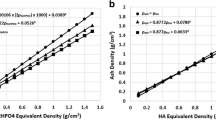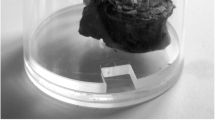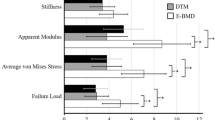Abstract
Peripheral quantitative computed tomography (pQCT) is a non-invasive, low-radiation tool for measuring volumetric bone mineral density. It has potential for use in fracture healing applications; however, the unknown attenuation effects of cast material on peripheral quantitative computed tomography have contributed to its limited use in this area. The effect of two common cast materials, polyester and Plaster of Paris was investigated by performing both in vitro and in vivo studies. The in vitro study tested the effect of increasing layers of cast material on bone density measurements performed on a hydroxyapatite phantom. Cast thickness was directly associated with a reduction in bone mineral density, with twelve layers of polyester and Plaster of Paris resulting in a 0.55 and 2.21 % decrease in bone density measurements. Precision error in situ with polyester cast material was 0.71 %, and 2.31 % with Plaster of Paris cast material. The in vivo study comprised a prospective trial with 28 healthy adult participants to evaluate the effect of the two cast materials. Trabecular bone mineral density was increased by 0.5 % in the presence of a polyester cast and decreased by 4.22 % in the presence of a Plaster of Paris cast. Cortical bone mineral density was decreased by 3.46 and 5.54 % for polyester and Plaster of Paris, respectively. This study quantified the effects of orthopaedic casts on pQCT-derived bone parameters. The results suggest applicability of commonly utilised cast materials in combination with pQCT to assess fracture healing.




Similar content being viewed by others
References
Braun MJ et al (1998) Clinical evaluation of a high-resolution new peripheral quantitative computerized tomography (pQCT) scanner for the bone densitometry at the lower limbs. Phys Med Biol 43(8):2279–2294
Rauch F, Schönau E (2008) Peripheral quantitative computed tomography of the proximal radius in young subjects—new reference data and interpretation of results. J Musculoskelet Neuronal Interact 8(3):217–226
Ebbesen EN, Thomsen JS, Mosekilde L (1997) Nondestructive determination of iliac crest cancellous bone strength by pQCT. Bone 21(6):535–540
Ebbesen EN et al (1999) Lumbar vertebral body compressive strength evaluated by dual-energy X-ray absorptiometry, quantitative computed tomography, and ashing. Bone 25(6):713–724
Tisosky AJ et al (2015) The factors influencing the refracture of pediatric forearms. J Pediatr Orthop 35(7):677–681
de Kooter M (2011) Quantification and reproducibility of morphological and mechanical bone parameters obtained by high-resolution peripheral quantitative CT images. Master’s thesis, Academic Hospital Maastricht, Maastricht University, Netherlands
Meyer U et al (2014) Early changes in bone density, microarchitecture, bone resorption, and inflammation predict the clinical outcome 12 Weeks after conservatively treated distal radius fractures: an exploratory study. J Bone Miner Res 29(9):2065–2073
de Jong JJA et al (2014) Assessment of the healing process in distal radius fractures by high resolution peripheral quantitative computed tomography. Bone 64:65–74
Neu CM et al (2001) Modeling of cross-sectional bone size, mass and geometry at the proximal radius: a study of normal bone development using peripheral quantitative computed tomography. Osteoporos Int 12(7):538–547
Gluer CC et al (1995) Accurate assessment of precision errors: how to measure the reproducibility of bone densitometry techniques. Osteoporos Int 5(4):262–270
den Boer FC et al (1998) Quantification of fracture healing with three-dimensional computed tomography. Arch Orthop Trauma Surg 117(6–7):345–350
Guglielmi G et al (1997) Long-term in vitro precision of single slice peripheral quantitative computed tomography (pQCT): multicenter comparison. Technol Health Care 5(5):375–381
Rinaldi G et al (2011) Peripheral quantitative computed tomography: optimization of reproducibility measures of bone density, geometry, and strength at the radius and tibia. J Clin Densitom 14(3):367–373
Swinford RR, Warden SJ (2010) Factors affecting short-term precision of musculoskeletal measures using peripheral quantitative computed tomography (pQCT). Osteoporos Int 21(11):1863–1870
Ferretti JL, Capozza RF, Zanchetta JR (1996) Mechanical validation of a tomographic (pQCT) index for noninvasive estimation of rat femur bending strength. Bone 18(2):97–102
Engelke K et al (2008) Clinical use of quantitative computed tomography and peripheral quantitative computed tomography in the management of osteoporosis in adults: the 2007 ISCD official positions. J Clin Densitom 11(1):123–162
Faulkner RA et al (1993) Regional and total body bone mineral content, bone mineral density, and total body tissue composition in children 8–16 years of age. Calcif Tissue Int 53(1):7–12
Acknowledgments
We would like to acknowledge the kind, expert assistance of Dr. Tim Spelman from the St Vincent’s Department of Surgery, and Emily Karahalios, from the Western Medical School, in the statistical analysis of this project. We would also like to thank the Western Health plaster technicians for their contribution in the application of casts for this project.
Author information
Authors and Affiliations
Corresponding author
Ethics declarations
Conflicts of Interest
None.
Ethical Approval
Ethics approval was obtained through Melbourne Health HREC (Melbourne Health HREC approval 2014.272).
Rights and permissions
About this article
Cite this article
Bullen, M., Blanchard, R., Rodda, C. et al. Effect of Polyester and Plaster of Paris Casts on Determination of Volumetric Bone Mineral Density Assessed by Peripheral Quantitative Computed Tomography (pQCT). Calcif Tissue Int 99, 454–461 (2016). https://doi.org/10.1007/s00223-016-0169-8
Received:
Accepted:
Published:
Issue Date:
DOI: https://doi.org/10.1007/s00223-016-0169-8




